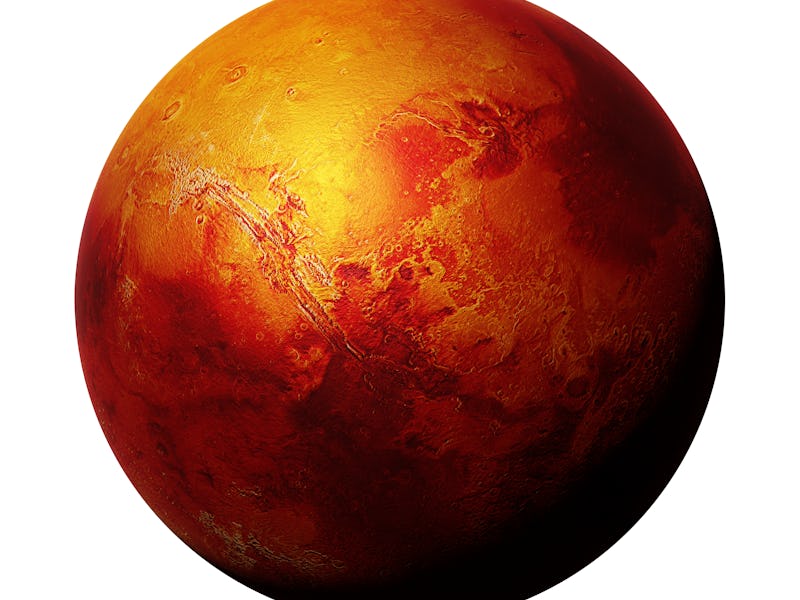Alien seekers may be salty about this new Mars study
Liquid water could cover 40 percent of the Martian surface.

In the search for habitability in a world other than our own, Mars tops the list of planets that scientists have been tirelessly investigating for signs of life.
A new study suggests that while there may be an abundant amount of water on Mars, it's not exactly habitable.
The study was published this week in the journal Nature Astronomy.
When it comes to finding life on other planets, water is a crucial component. However, the new findings show that the presence of water is futile if that water is not suitable for sustaining life.
Previous observations of Mars has suggested that water flows on the Red Planet. In 2015, data collected by NASA's Reconnaissance Orbiter revealed signatures of hydrated minerals on slopes where mysterious streaks marked the Martian surface. The streaks appeared to ebb and flow depending on the season, darkening and appearing to flow during warmer weather and fading in cooler times, according to NASA.
Images from NASA's Phoenix Lander show potential droplets of brine on the surface of Mars.
Some scientists believe that water on Mars would need to have high concentrations of salt, or rather a solution of water known as brines. Due to Mars' extreme temperatures that are on average -80 degrees Fahrenheit, and its dry conditions, fresh water would freeze, boil or evaporate on Mars. However, salt water has a lower freezing temperature than fresh water, and evaporates at a slower rate.
The team of researchers behind the new study used spacecraft observations of Mars, along with planetary models, to create a model of Mars that predicts where brines would exist on the Red Planet, along its surface and shallow subsurface.
The study found that brines could cover up to 40% of the Martian surface. However, the water would flow on Mars seasonally, for only about 2% of the Martian year, which is the equivalent of 687 Earth days, while Mars' subsurface could hold brines for about 10% of the Martian year.
The above figure shows the distribution of brines on Mars based on the new study.
However, the study also found that in the best case scenario, brine would exist in temperatures that only go as high as -55 degrees Fahrenheit. These extremely cold temperatures are not exactly suitable for life in any form, the researchers conclude.
“We have shown that on a planetary scale the Martian surface and shallow subsurface would not be suitable for terrestrial organisms because liquids can only form at rare times, and even then, they form under harsh conditions," Edgard G. Rivera-Valentín, a scientist at the Universities Space Research Association (USRA) at the Lunar and Planetary Institute (LPI) and lead author of the study, said in a statement. "However, there might be unexplored life on Earth that would be happy under these conditions.”
But so far, we don't know of this form of life that may be able to withstand the harsh environmental conditions of Mars.
On the other hand, the new study does have a narrow silver lining. As space agencies continue to send out spacecraft and robots to explore Mars, scientists have worried about the chances of contaminating the Red Planet with terrestrial life from Earth. However, now we can rest assured that even if we do bring along tiny microscopic life to Mars, it will likely not survive.
Abstract: Special Regions on Mars are defined as environments able to host liquid water that simultaneously meets certain temperature and water activity requirements that allow known terrestrial organisms to replicate1,2 and therefore could be habitable. Such regions would be of concern for planetary protection policies owing to the potential for forward contamination (biological contamination from Earth). Pure liquid water is unstable on the Martian surface3,4 but brines may be present3,5. Experimental work has shown that brines persist beyond their predicted stability region, leading to metastable liquids6,7,8. Here we show that (meta)stable brines can form and persist from the equator to high latitudes on the surface of Mars for a few percent of the year for up to six consecutive hours, a broader range than previously thought9,10. However, only the lowest eutectic solutions can form, leading to brines with temperatures of less than 225 K. Our results indicate that (meta)stable brines on the Martian surface and its shallow subsurface (a few centimetres deep) are not habitable because their water activities and temperatures fall outside the known tolerances for terrestrial life. Furthermore, (meta)stable brines do not meet the Special Region requirements, reducing the risk of forward contamination and easing threats related to the exploration of the Martian surface.